Points to Ponder While Choosing Your First UEM Solution
This article offers practical insights and decision-making tips for IT managers evaluating UEM platforms.

Get fresh insights, pro tips, and thought starters–only the best of posts for you.

In today’s hybrid work environment, managing a diverse fleet of devices – ranging from smartphones and laptops to rugged handhelds and IoT endpoints – requires a robust Unified Endpoint Management (UEM) solution.
Two leading contenders in this space are Hexnode and SureMDM, each offering a unique blend of features, integrations, and deployment flexibility.
This blog provides a comprehensive comparison of Hexnode vs SureMDM, helping IT managers in small to medium-sized businesses evaluate which platform best aligns with their operational needs, security requirements, and budget constraints. From platform support and device compatibility to pricing, user experience, and customer support, we break down the key differences to guide your decision-making process.
When evaluating UEM solutions, Hexnode and SureMDM stand out as two robust platforms designed to simplify device management across diverse environments. Both offer cloud-based solutions with extensive OS support, but they differ in approach, integrations, and specialization.
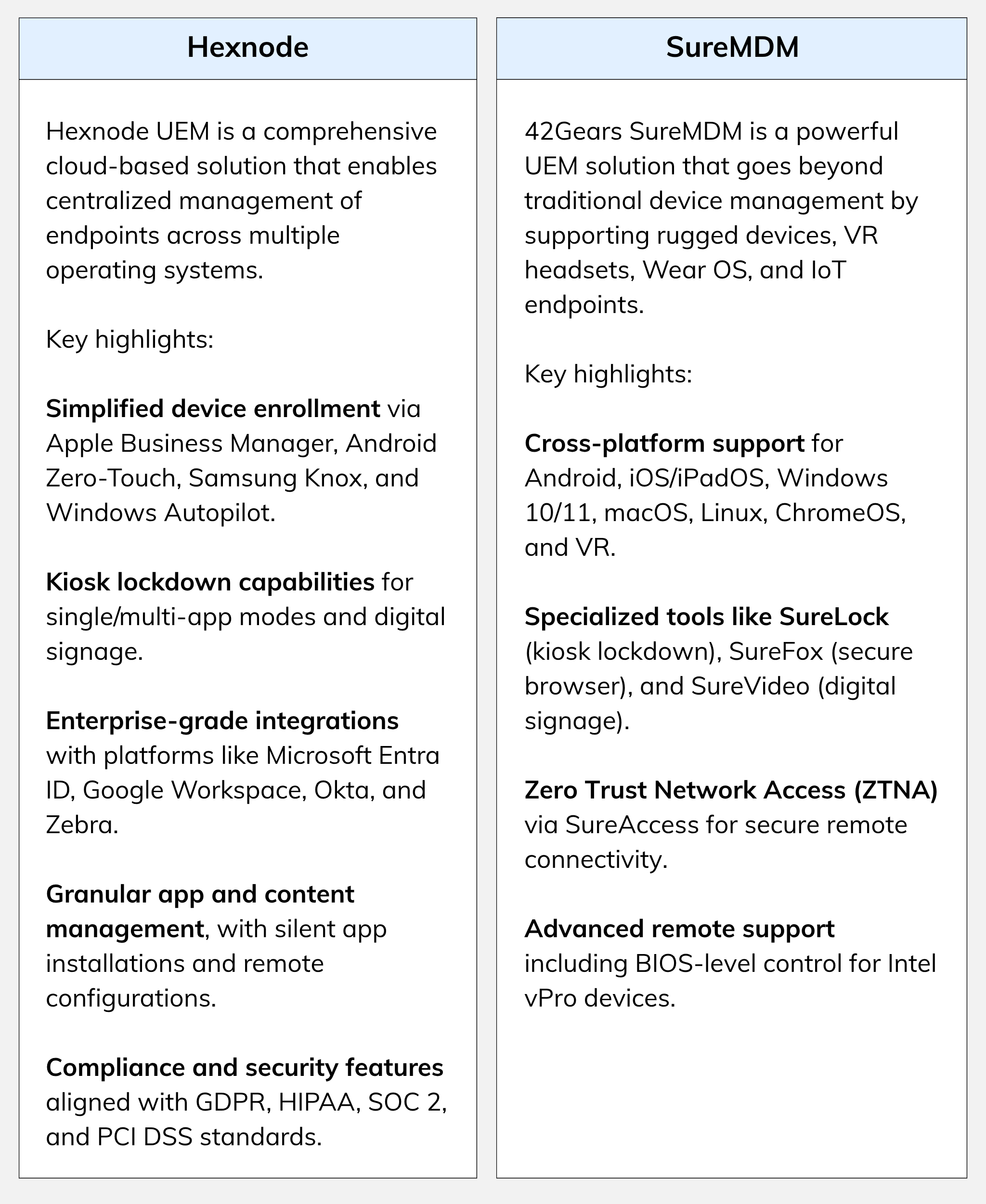
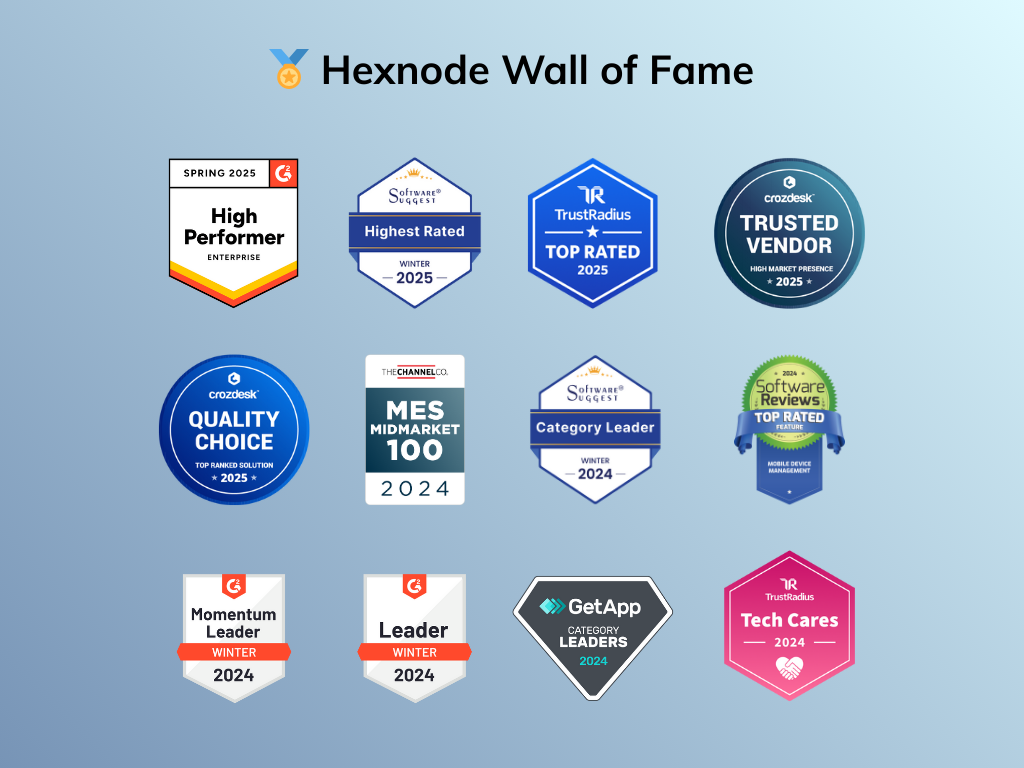
When choosing a UEM solution, platform coverage and device compatibility are critical factors. Both Hexnode and SureMDM offer extensive support across operating systems and device types, but they cater to slightly different enterprise needs.
Hexnode UEM supports a wide range of platforms, making it ideal for organizations with diverse device ecosystems:
Mobile & Desktop OS: Android (5.0+), iOS/iPadOS (11.0+/13.1+), Windows 10/11, macOS (10.7+), Linux (Ubuntu, Fedora, Debian), ChromeOS, Fire OS, tvOS, and visionOS.
Enrollment Methods: Automated Device Enrollment (Apple), Android Zero-Touch, Samsung Knox, Windows Autopilot, QR code, and email/SMS-based enrollment.
Device Types: Smartphones, tablets, desktops, laptops, smart TVs, wearables, and even AR/VR devices running visionOS.
Remote Actions: Platform-specific remote actions like device scanning, location tracking, app inventory, and compliance checks are supported across most OSes.
Hexnode’s recent expansion into Linux, ChromeOS, and visionOS further strengthens its position as a versatile UEM solution for modern enterprises.
42Gears SureMDM is designed with rugged environments and specialized devices in mind:
Supported Platforms: Android, iOS/iPadOS, macOS, Windows 7/8/10/11, Linux, ChromeOS, Wear OS, VR, Windows Mobile/CE, and IoT devices.
Device Types: Smartphones, tablets, desktops, rugged handhelds, smartwatches, VR headsets, printers, RFID readers, and IoT endpoints.
Enrollment Options: Android ZTE, Knox Mobile Enrollment, Apple Business Manager, Windows Autopilot, QR code, and manual app-based enrollment.
Specialized Tools: SureLock (kiosk lockdown), SureFox (secure browser), and SureVideo (digital signage) enhance compatibility with niche devices.
SureMDM excels in industries like logistics, manufacturing, and field services, where rugged and wearable devices are common.
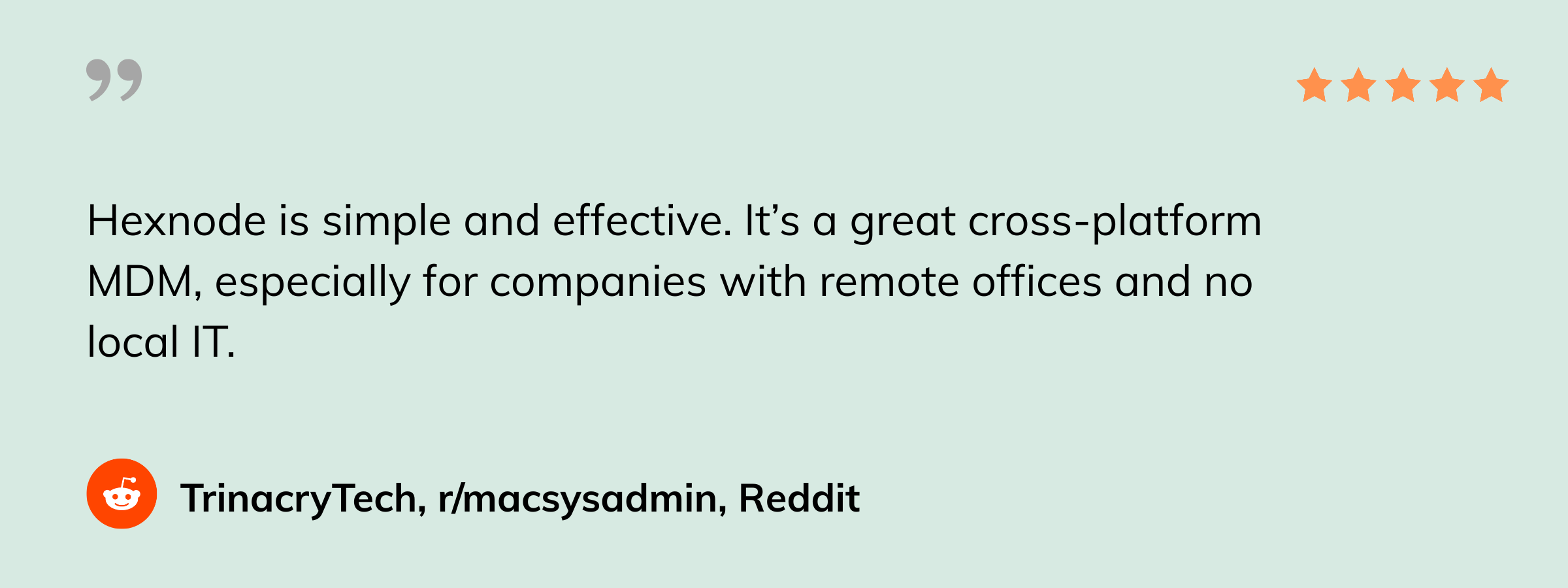
Security and regulatory compliance are non-negotiable for IT managers managing sensitive data across endpoints. Both Hexnode and SureMDM offer enterprise-grade security frameworks, but they differ in depth, certifications, and specialized tools.
Hexnode UEM is built with a strong focus on data protection, compliance, and endpoint security:
Certifications:
Security Features:
Compliance Management:
Hexnode’s layered security model and automated compliance enforcement make it ideal for SMBs with strict regulatory requirements.
42Gears SureMDM emphasizes Zero Trust principles and compliance across rugged, wearable, and IoT devices:
Certifications:
Security Features:
Compliance Tools:
SureMDM is a strong choice for organizations managing rugged or niche devices in regulated industries like healthcare, logistics, and manufacturing.
A well-designed user interface (UI) and intuitive user experience (UX) are essential for IT teams to manage endpoints efficiently and for end-users to interact with minimal friction.
Hexnode UEM emphasizes a clean, modern interface with extensive customization options for both IT admins and end-users:
Admin Dashboard:
End-User Experience:
Desktop Customization:
Hexnode’s UI is ideal for SMBs that value branding, user control, and a streamlined experience across platforms.

42Gears SureMDM offers a unified interface designed for managing diverse device types, including rugged, wearable, and VR endpoints:
Admin Console:
End-User Experience:
SureMDM prioritizes functionality and control, making it ideal for environments where simplicity and restriction are key – like retail, logistics, and field operations.
Integration capabilities are essential for UEM platforms to fit seamlessly into existing IT ecosystems.
Hexnode UEM provides a wide range of integrations across identity management, security, productivity, and OEM platforms:
Identity & Directory Services:
Security & Compliance Tools:
ITSM & Support:
OEM & Device-Specific Integrations:
Hexnode’s integrations are ideal for SMBs using cloud identity platforms and seeking compliance automation and device-specific controls.
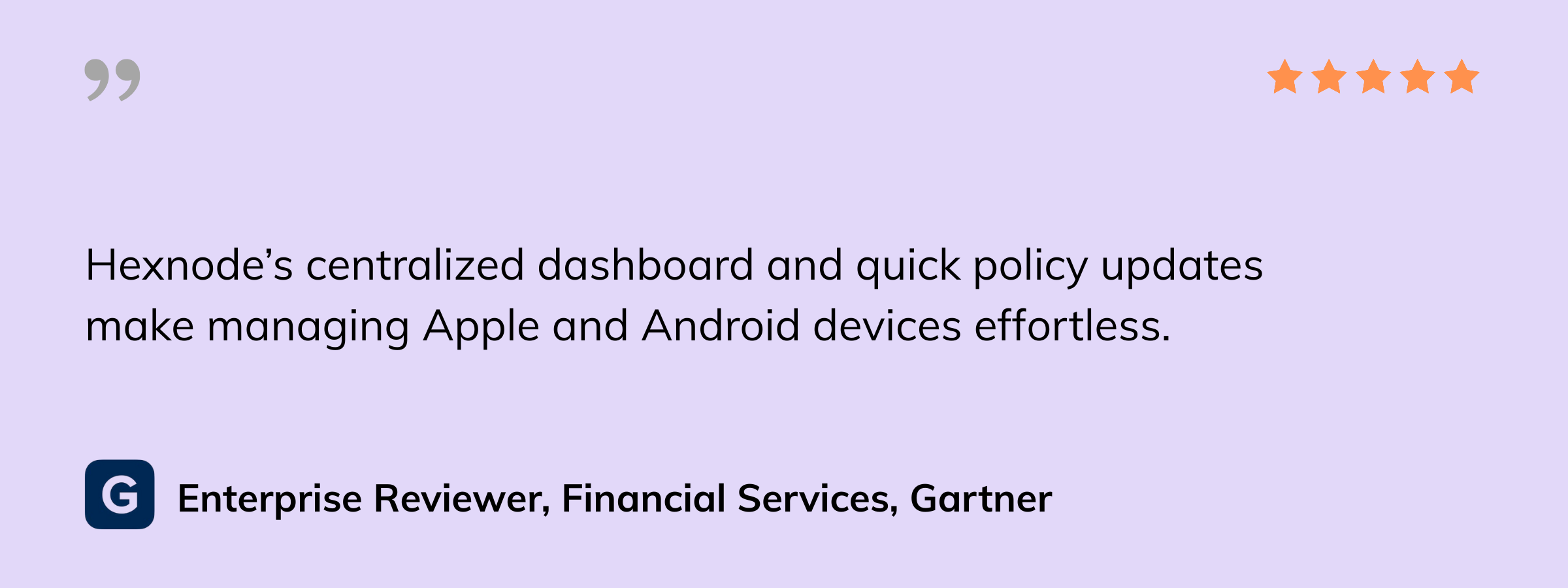
42Gears SureMDM focuses on integrations that enhance security, network access, and rugged device management:
Security & Network Integrations:
Remote Management:
OEM Integrations:
Ecosystem Support:
SureMDM is ideal for SMBs in logistics, manufacturing, and healthcare that require rugged device support and advanced network security integrations.
Cost-effectiveness and licensing flexibility are key considerations for SMBs when choosing a UEM solution.
Hexnode UEM offers four subscription tiers, all billed per device per month, with discounts for annual billing:
Hexnode’s pricing is transparent and ideal for SMBs looking for predictable costs and flexible scaling.
42Gears SureMDM offers three main pricing tiers, with both SaaS and perpetual licensing models:
Licensing Models:
SureMDM offers more deployment flexibility, making it suitable for SMBs with specific infrastructure or compliance needs.
Responsive customer support and a vibrant user community are essential for IT teams managing complex endpoint environments.
Hexnode UEM provides multi-channel support and a dynamic community platform:
Support Availability:
Resources:
Community Engagement:
Hexnode’s support ecosystem is ideal for SMBs seeking structured learning, peer engagement, and responsive assistance.

Get a clear overview of UEM architecture, platform coverage, and strategic benefits. Ideal for IT managers evaluating Hexnode against other solutions.
Download White paper42Gears SureMDM offers round-the-clock support and a resource-rich community:
Support Availability:
Resources:
SureMDM is well-suited for SMBs operating in high-availability environments that require immediate support and technical depth.
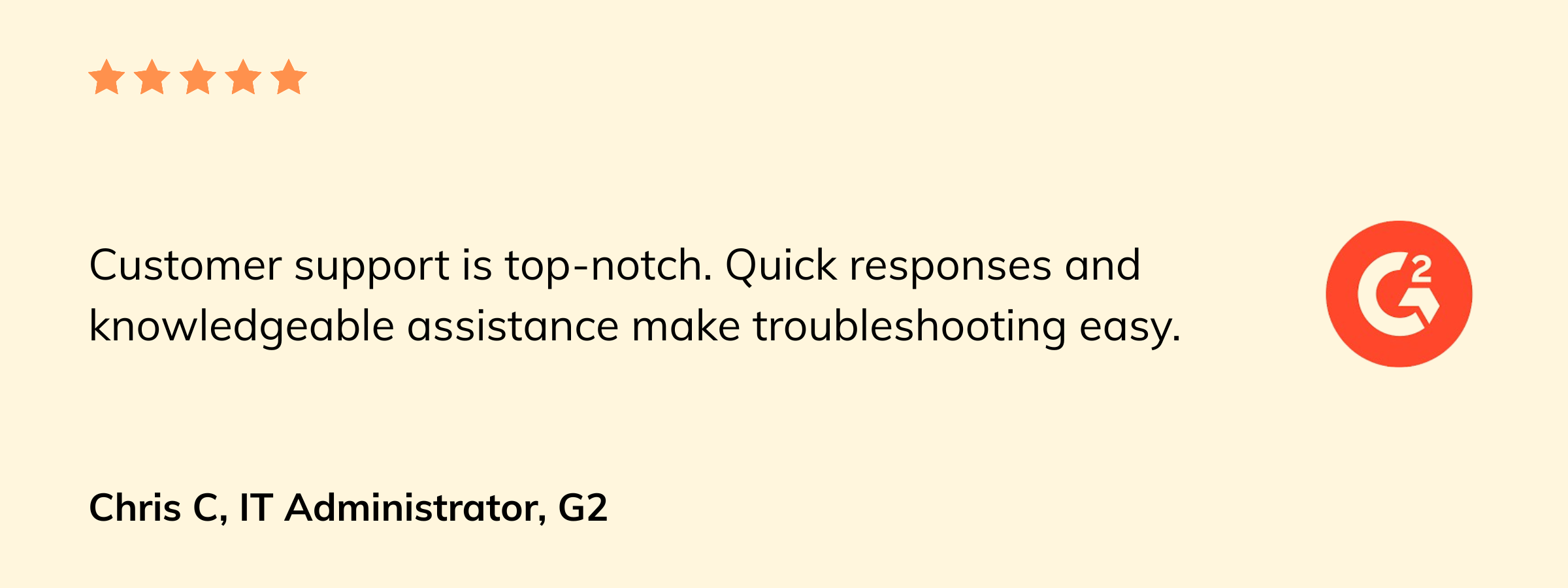
Can Hexnode or SureMDM be deployed on-premise?
SureMDM offers both cloud and on-premise deployment options. Hexnode is primarily cloud-based and does not currently support on-premise deployment.
Which solution is more suitable for BYOD environments?
Both platforms support BYOD, but Hexnode offers more granular control over work profiles and app-level restrictions, making it slightly more flexible for mixed-use devices.
Do I need to factory reset devices to enroll them in Hexnode or SureMDM?
No, factory reset is not required for most enrollment methods. However, Android Enterprise Device Owner mode and Apple Configurator enrollment may require a reset in Hexnode.
Which platform has better integration with identity providers like Azure AD and Okta?
Hexnode offers deep integrations with Microsoft Entra ID (Azure AD), Okta, Google Workspace, and Active Directory. SureMDM also supports Azure AD and Okta but focuses more on network and security integrations.
How do the pricing models differ between Hexnode and SureMDM?
Hexnode uses a per-device monthly pricing model with four tiers. SureMDM offers both subscription and perpetual licensing, with add-ons like SureLock and AstroFarm available separately.
Can I manage macOS and Windows devices equally well with both platforms?
Hexnode offers strong cross-platform support with advanced macOS and Windows policy management. SureMDM supports both but is more optimized for Android and rugged devices.
Choosing between Hexnode and SureMDM ultimately depends on your organization’s device landscape, industry focus, and IT priorities.
Hexnode shines with its clean UI, broad OS support, deep directory integrations, and strong compliance features – making it ideal for SMBs with mixed device environments and regulatory obligations.
SureMDM, on the other hand, excels in managing rugged, wearable, and IoT devices, offering advanced remote support, Zero Trust security, and flexible deployment models – perfect for industries like logistics, manufacturing, and healthcare.
Both platforms offer scalable pricing, responsive support, and rich integration ecosystems. By understanding their strengths and limitations, IT managers can confidently choose the UEM solution that delivers the best value and control for their organization.
You've compared the features - now experience them firsthand.
Start Free Trial Now